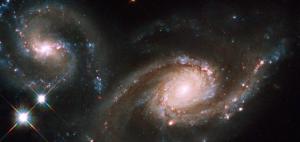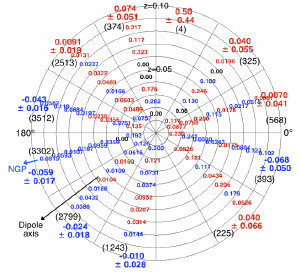Blog
The Gripping Hand
30 September 2014
 NASA/Hubble
NASA/HubbleThe image above shows a pair of colliding spiral galaxies known as Arp 274. What’s interesting is not that they happen to be colliding, but that the two galaxies are spiraling in opposite directions. The one on the left spirals in a clockwise direction, while the one on the right spins in a counterclockwise direction. Sometimes we’ll refer to the left galaxy as left-handed, while the right one is right-handed. The reason is that if you hold hands up with your thumbs pointing at yourself, you’ll see the fingers on your left hand curve clockwise, and the fingers on your right hand curve counterclockwise.
These two galaxies just happen to spiral in opposite directions, but it raises an interesting question. Is there a statistical bias to the orientation of spiral galaxies? That is, are there more left handed spiral galaxies than right handed ones, or vice versa? Intuitively you would think not. If galaxies are oriented in random directions, then we’d expect to see an even mix of right and left handed spiral galaxies (when we can tell a direction). Still, with crowdsourced science it is a fairly straightforward thing to test, and this is exactly what was done over at Galaxy Zoo.
What the team did was take images of about 35,000 spiral galaxies, and had volunteers determine whether each one was right-handed or left-handed. They made sure each galaxy was evaluated by multiple people, and only took a direction as “determined” if 4 out of 5 volunteers agreed on a particular direction. What they found was of the clearly decided spiral galaxies, about 52% were right-handed, and 48% left-handed. This is very clearly a bias toward right-handed galaxies. The chance of that happening purely by chance is about 1 in 400 trillion.
That might seem like clear evidence of some inherent handedness to spiral galaxies, but you have to be careful about drawing conclusions too quickly. One of the well known phenomena in psychology is the fact that people have a bias towards right-handedness. Whether it is innate or culturally driven is not clear, but in general we tend to prefer right-handed things to left-handed ones. Of course the way to check for this bias is to flip all the images and run the test again. If there really is a handedness to spiral galaxies, then we should see the left-handed galaxies outnumber the right-handed ones. What actually happens is the results are unchanged. You again get about 52% right-handed and 48% left handed.
In the words of Pogo, “We have met the enemy, and he is us.” The bias is real, but it’s due to human observers rather than a physical bias in spiral galaxies. This is why you need to be careful with crowdsourced data, particularly when that data depends upon a human judgement call.
For example, a couple years ago a paper came out showing an interesting pattern in the directions of spiral galaxies.1 Looking in one direction of the universe, there was a slight bias of right-handed spiral galaxies, while looking in the opposite direction there was a slight bias of left-handed galaxies. This is interesting because it is exactly what you would expect to see if there is an innate handedness to the universe.
 Michael Longo
Michael LongoTo understand why handedness should vary with direction, imagine you and a friend are standing on opposite sides of a street. You see a car drive slowly along the road. From your vantage point, you see the car move from right to left, and you see the tires clearly rotating in a right-handed (counterclockwise) direction. Your friend, however, sees the car move from left to right, and sees the tires rotate in a left-handed (clockwise) direction. The tires are all rotating in the same way, but you and your friend see the tires rotate with different handedness because you view things from opposite directions. The same is true for the universe. If all the spiral galaxies rotated the same way, we should expect to see right-handed spirals in one direction of the sky, and left-handed spirals in the opposite direction.
This effect is small, but the odds of it being purely chance is about 1 in 10,000. But is this a real signal, or is it noise. The author did account for left-right bias by flipping images and such, but given that human bias can give a 1 in 400 trillion shift, it’s hard to be sure that human bias has been completely accounted for. So it’s an interesting result, but not really a compelling result.
I should emphasize that human bias does not mean that all crowd-sourced data is worthless, or even that this particular work with spiral galaxies is bad. It simply means that crowd analyzed data must be dealt with carefully so that human bias doesn’t creep into your results. But that’s an issue even professionals have to deal with.
After all, everyone tends to favor their gripping hand.
Longo, Michael J. “Detection of a dipole in the handedness of spiral galaxies with redshifts z∼ 0.04.” Physics Letters B 699.4 (2011): 224-229. ↩︎